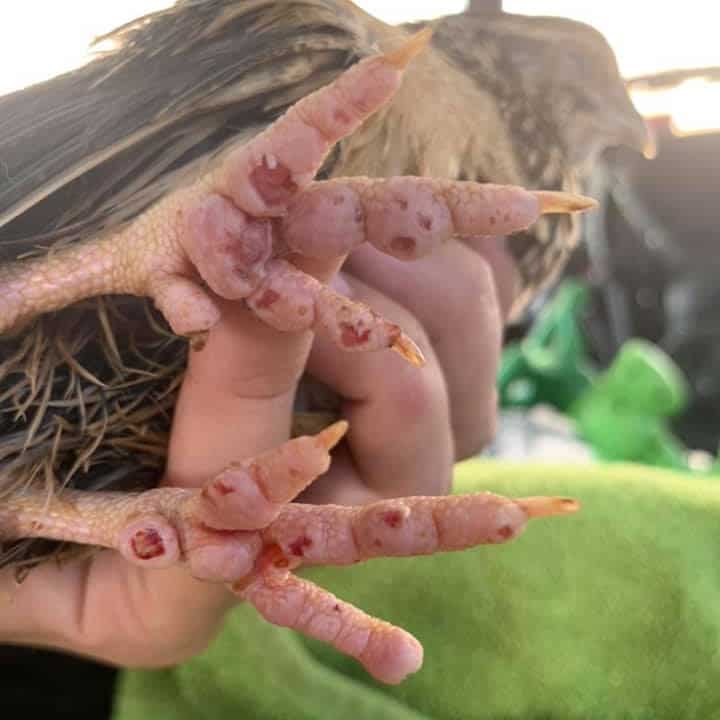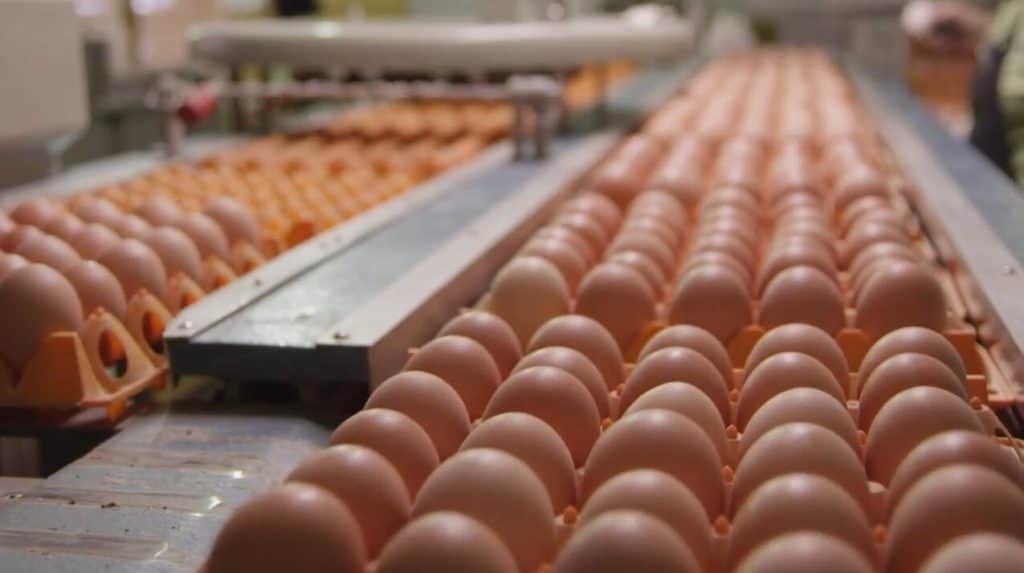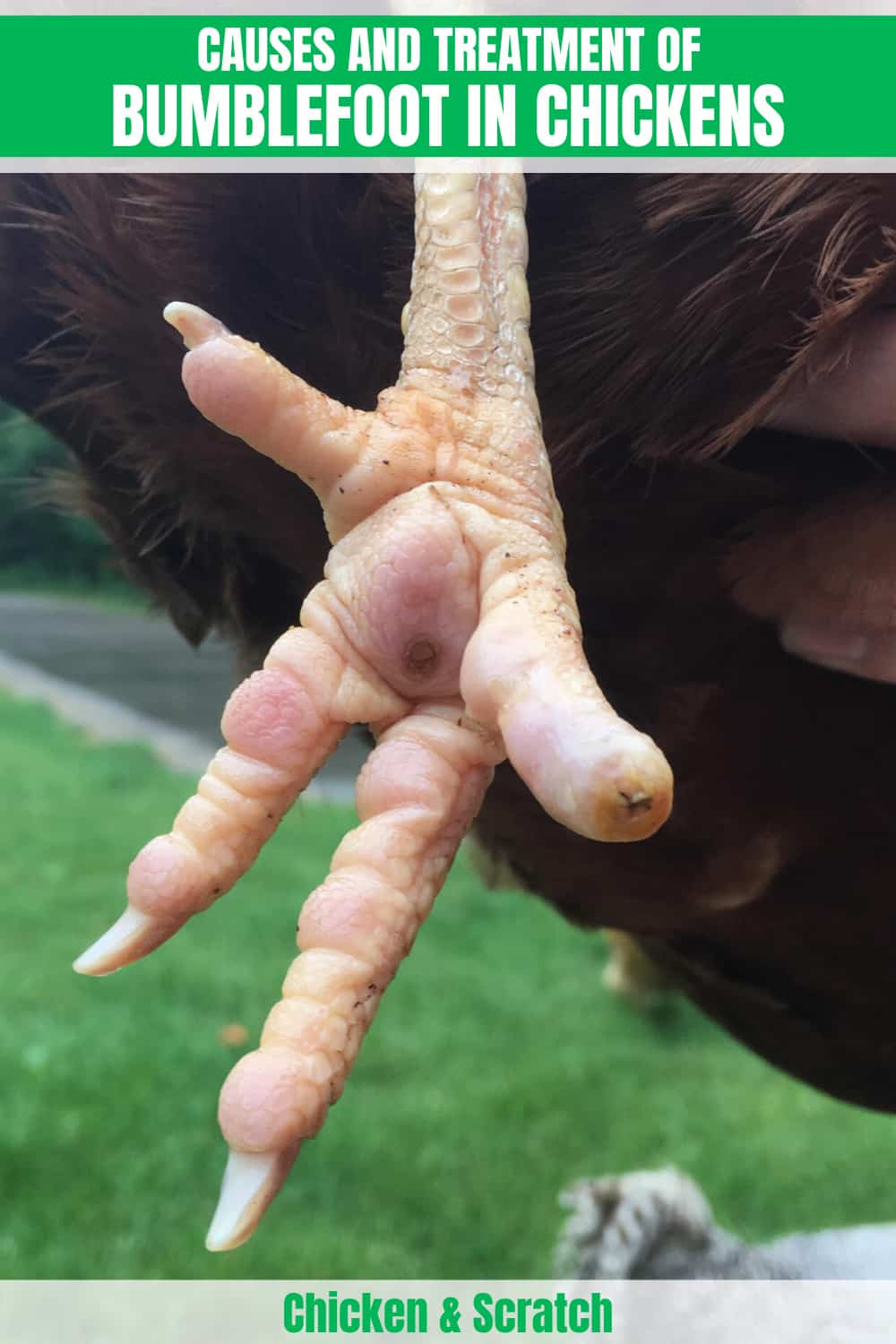Bumblefoot, also known as plantar pododermatitis, is a grave condition for chickens. It’s a dangerous bacterial infection that becomes inflamed and noticeable when hard round lumps form on one or both of a chicken’s feet.
Bumblefoot can move beyond the surface of the feet into deeper structures of the chicken, such as tendons and joints. When left untreated, it can spread into the chicken’s bloodstream.
Direct Causes of Bumblefoot

The infection is commonly a direct result of certain bacteria—such as Escherichia coli (E. coli), Pseudomonas, or Staphylococcus—that form cysts in the foot tissues. Once established, the infection progresses rapidly, forming an abscess or chronic outward wound.
Harmful bacteria gain entry into the chicken’s foot through an open wound. It could be in any part of the sole. The condition is most common in backyard flocks and typically indicates bad coop hygiene or poor husbandry.
A common question about bumblefoot is if it’s caused by walking on wet ground. While it doesn’t cause bumblefoot on its own, it can make it more likely that a chicken will contract it. However, the real cause of bumblefoot is most often acquired in the coop. Examples are square or sharp edges on perches or rough edges on the chicken’s nesting boxes.
It’s important to note that metal nesting boxes—that are pre-built—are harmful because a lot of them have ultra-fine edges. Those materials easily slice through the foot of a chicken.
Chickens in the wild are known to nest in places like tree limbs that have round perches. The perches you provide in the coop should be the same or similar.
Some of the primary bumblefoot risk factors are:
- Rough or sharp edges on nest boxes, perches, and roosts
- Dirty or damp runs and coops
- Existing foot injuries
- Fecal accumulation on the ground
- Muddy, rigid, or compacted run surfaces
- Vitamin deficiency (especially vitamin A) or a bad diet
- Leg or foot malformations that are genetic
- Aggression and fighting
- Toenails that are overgrown due to inactivity
- Poorly conditioned or overweight chickens that suffer from other conditions
- Past occurrence of bumblefoot
- The presence of leg mites
Now that we’ve covered some significant risk factors: Let’s look at symptoms.
Bumblefoot Symptoms

Visible signs of bumblefoot include discolorations or abrasions and visible wounds on the bottom of the feet. As the infection progresses, you’ll notice more severe symptoms such as hobbling or overall lameness.
The chicken’s feet might be hot to your touch, which is not normal for healthy chickens. During the later stages of bumblefoot, their feet might smell.
Bumblefoot can be diagnosed through behavioral and physical examinations. Look at, and feel their feet and keep a close eye on how they move. Bumblefoot that has progressed to later stages could require an x-ray. It will help see if it has spread to any bones or joints.
he infection is graded on a scale of 1 to 5. One is a mild form of bumblefoot, and five is a severe case.
- Stage 1. It is the very beginning of the infection. It’s distinguished by a slightly raised shiny patch on the bottom of the foot.
- Stage 2. In this stage, there’s the beginning of a sore on the chicken’s sole. The infection has started but hasn’t begun to swell yet.
- Stage 3. Abscesses start to form. And swelling becomes visible, although you may not be able to notice the chicken limping. Dead or necrotic tissue forms and has a cheese or butter-like appearance. The feet can start to smell as well.
- Stage 4. In this advanced stage, swelling and infection have spread beyond the tissues and into bones, joints, and tendons. The wound has become chronic and will not self-heal.
- Stage 5. The foot becomes permanently infected and crippled. The infection becomes so bad that it starts to spread throughout the foot and is visible on the top of the foot.
Bumblefoot Left Untreated
Untreated bumblefoot can begin to develop into a sore that consumes the entire foot of the chicken, causing lameness.
The infection doesn’t often heal without treatment because of a chicken’s slightly odd foot and leg structure. If you leave it untreated, you’ll end up with a bird that’s 100% lame and in a lot of pain.
Treating Bumblefoot

The process of treatment begins with wrapping your chicken up in a towel. It will keep it in the dark and stop all the flapping. This intervention to rid your chicken of early-stage bumblefoot involves emptying the foot’s cavity. Then, cleaning out the wound. After, you want to cover the injury with a sterile dressing.
In more advanced stages, the infection will need to be removed by a trained veterinarian.
The four treatment phases involve:
- Thoroughly clean the chicken’s foot and soak it in warm water and Epsom salts to remove the scab. Some veterinarians might suggest that you douse the foot in antibiotic treatment, such as a Tricide Neo solution.
- Remove the abscesses with a saline flush. Surgical Debridement, as you would say in medical terms. In this process, the wound washes out with iodine or chlorhexidine.
- Bandage the foot with a colloidal dressing that keeps the wound moist and clean until fully healed.
- Change the living condition set up to help ensure the infection doesn’t return.
It’s essential to quarantine chickens that suffer from bumblefoot. Also, never allow them to perch for a minimum of two weeks until the foot has fully healed.
Antibiotics for Bumblefoot
Under most circumstances, veterinarians won’t prescribe antibiotics for bumblefoot. That is unless the infection has spread to joints or bones.
Natural Bumblefoot Treatments

Natural treatments are the best option for birds suffering from bumblefoot that haven’t yet had the infection enter the foot.
For natural treatments, first, you want to separate the infected bird from the rest of the flock, then:
- Clean and soak the foot as described above.
- Bandage the foot as described above and change every day.
- Add a few drops of Lavender essential oil to the dressing to promote faster healing.
Of course, infections that have progressed beyond stage three need professional help. But you should still use natural treatment methods to support faster healing.
Tips To Prevent Bumblefoot in Chickens
Placing yourself one step ahead of unwanted scenarios is the best approach to avoid bumblefoot. So let’s take a look at some key points to remember.
Maintain a clean environment
Ideally, tidy the coop weekly and once a month for deep cleaning. The former means clearing out the dropping, feathers, and others. The latter, conversely, means relocating the chickens to a temporary shelter. And replacing soiled beddings and floorings.
Choose an even ground substrate
Wire flooring heightens the risk of chickens getting open wounds. Layering sand is ideal, providing a soft ground for their feet. It is also excellent for a long-term environment—plus it is low-cost.
Encourage exercise
Chickens have a broad body with stick-like legs, which is unideal for overweight ones. Provide stimulating toys inside the coop, like a swing or a seesaw. It will encourage them to jump and move around instead of eating all day.
Provide a balanced diet
Along with exercise, a proper diet is crucial to avoid having an obese chicken. If your hen is a glutton, you can use the treat to bribe it to do exercises. But ensure to portion it based on the required daily intake. Some treats you can try are berries, watermelon, and peaches.
Ensure the coop litter is dry
Letting it dry prevents unwanted organisms from burrowing on the floor. So, choose something that drains away any spill, like sand.
Can Bumblefoot Be Lethal?
This condition is very rarely fatal. However, extremely untreated cases can kill chickens. When their feet are severely sore, they lose interest in perching, dust bathing, and eating.
The condition can be lethal to a chicken if:
- Their feet are so sore, infected, and damaged that they can’t move well enough to drink or eat
- The bumblefoot infection begins to spread and gets into hollow bones
Chickens have been found to die from complications of untreated bumblefoot. But if you treat the condition properly, death is not likely.
Can I Eat Eggs From a Hen Suffering From Bumblefoot?

It’s safe to eat eggs from a hen that has bumblefoot unless the chicken is undergoing antibiotic treatment.
If your hen is undergoing antibiotic treatment, it’s best not to consume the eggs for at least seven days after it completes the treatment.
Can Other Chickens Catch Bumblefoot?
Bumblefoot is not contagious. Chickens can’t catch it from each other. But if one chicken has bumblefoot, there’s a high likelihood that other chickens will get it as well.
Bacteria that cause bumblefoot are everywhere. If one chicken is suffering from bumblefoot, it means the conditions are present in your pasture, coop, or run for other chickens to contract it.
But they don’t “catch” it from one another.
Are Certain Breeds at More Risk Than Others?

The answer to this seems to be yes. Breeds with feathered feet or extra toes are more likely to contract the condition.
However, the conditions in which chickens are kept are a far greater concern than their breed.
Do People Ever Get Bumblefoot?
A person can get infected with bumblefoot, but it’s impossible to “catch” from a chicken. The abscess in the foot of an infected chicken is full of harmful bacteria. Take a lot of care when you treat and handle the birds.
What About Ducks and Other Forms of Poultry?
Bumblefoot is common in all domesticated waterfowl and poultry, like ducks, quail, guinea fowl, and chickens. Any consistent walking on sharp, rough, or hard surfaces can cause tiny wounds on the bottom of any poultry’s feet.
If you keep ducks on hard ground out of the water, they’re much more likely to contract bumblefoot.
Prognosis: Positive
If it receives immediate care, the prognosis of bumblefoot is good. If the condition is allowed to progress and fester, the overall prognosis tends to get worse.
Avoid allowing the infection to spread into a chicken’s bones. That way, you can keep them safe from further harm and work toward recovery.
Take Away
Good husbandry and a well-maintained environment help prevent bumblefoot in chickens. But this is not only the case for silly chickens in the coop. Some may get it from a fight, a hard landing, or unmaintained weight. Once these unavoidable circumstances occur, utmost care and treatment are what your chickens need from you.

Joseph Hudson has been raising chickens for over 15 years. In 2018, he completed the Agriculture & Natural Resources program at Mt. San Antonio College. He currently raises over 1400 chickens on his 7.5-hectare farm. He keeps sharing his experience on raising healthy and happy chickens on Chicken Scratch The Foundry.







